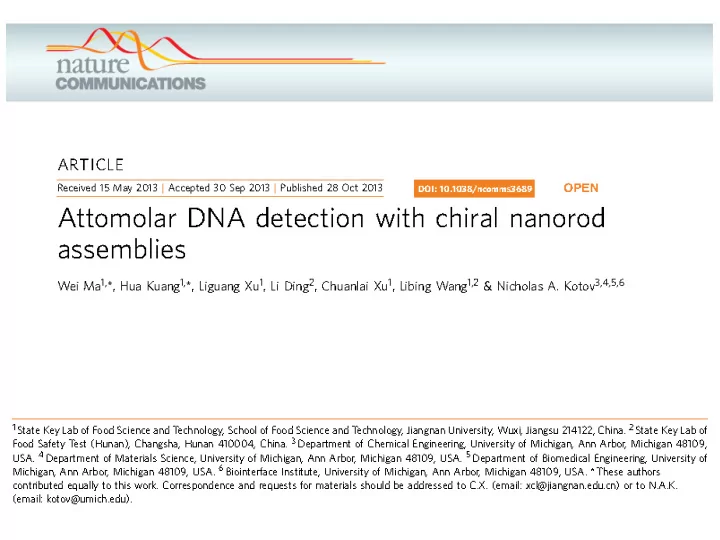

In this study... • Bioanalytical • Bioanalytical properties of self properties of self assembled chiral assembled chiral nanoscale nanoscale superstructures. superstructures. • LOD reached by SBS • LOD reached by SBS NRs using chiral NRs using chiral bisignate plasmonic bisignate plasmonic signals could be signals could be markedly lower than markedly lower than other widely other widely discussed methods . discussed methods . Schematics for PCR assembly of Au NRs. (a) PCR replication procedure in which a DNA strand can be amplifjed using primer, template DNA, taq plus polymerase and four difgerent DNA bases. (b) PCR-based gold NRs ETE assembly. (c) PCR-based gold NRs SBS assembly with inter-NR gap d; in the bottom part of the panel the DNA chains were removed for clarity.
Structure and optical properties of ETE assemblies of Au NRs . (a–f) Representative TEM images for ETE assembly obtained after difgerent number of PCR cycles, n=0 (a), 2 (b), 5 (c), 10 (d),15 (e) and 20 (f); scale bar, 50 nm. (g,h) Ultraviolet–visibl e (g) and CD spectra (h) for ETE assembly obtained for difgerent n. (i) Intensity of absorption maxima for ETE assemblies obtained for difgerent n. The error bars
Structure and optical properties of SBS assemblies of Au NRs (a–f) Representative TEM images for SBS assemblies obtained after difgerent number of PCR cycles, n=0 (a), 2 (b,c), 5 (d), 10 (e) and 15 (g,h) C- TEM tomography images for trimer (g) and pentamer (h) (i, j) UV (i) and CD spectra (j) for SBS assemblies with n=0–30. (k) Evolution of spectral features of SBS NR assemblies represented by λL, λp λn with
Schematics of twisted dimer, trimer, tetramer, and pentamer according to TEM tomography with angles of -9.0, -7.1, -8.0, -7.0 deg used in the simulations of chirooptical properties of the DNA-bridged assemblies. Representative cryo TEM tomography imagefor (a) NR trimer and (b) tetramer. T wist angles were determined to be-7 degand -8 degfor (a) and (b), respectively.
DNA analysis with SBS NRs assemblies. (a,b) Experimental ultraviolet–visible (a) and CD spectra (b) for NR assemblies obtained for difgerent DNA concentrations starting from 0.156nM with stepwise 10 dilution. (c) Calibration curves obtained using CD and ultraviolet–visible spectra of SBS assemblies. The error bars represent the standard deviation of sample measurements.
DNA analysis using SERS capabilities. (a,b) SERS intensity of 4-ATP tag at 1,083cm1 and 1,590 cm1 for ETE and SBS NR assemblies obtained after difgerent n (a) and difgerent starting DNA concentrations (b). (c) Calculated dependence of the intensity of the surface E-fjeld and CD intensity for a NR pentamers with gaps of 2, 5, 10, 20, 30 and 40 nm. (d) Calculated CD spectra for NR pentamers with gaps of 2, 5, 10, 20, 30 and 40 nm. The error bars represent the standard deviation of
CONCLUSION CONCLUSION • SBS assemblies of plasmonic NRs with strong polarization rotation make possible detection of DNA markers with unusually low LOD that is greatly needed for medical diagnostics, forensics and environmental needs. • The physical phenomena behind this capability include enhancement of polarization rotation by plasmonic structures, chiral symmetry breaking for SBS assemblies and bisignate nature of CD spectra. • Chiroplasmonic method of detection has sensitivity advantage for the analysis of biomolecules greater than 2 nm, while other plasmonic methods could be preferred for smaller analytes, unless steps for narrowing the gap by depositing additional layers of plasmonic material are taken. • The high sensitivity of the CD signal to geometry of the twisted NR assembly allows for experimental observation of the torsional dynamics of helical systems in solutions and
Recommend
More recommend